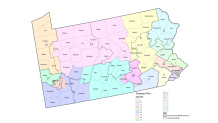What to Know
- The once-a-decade process of drawing up new congressional and state legislative districts began late last year in Pennsylvania. It's called redistricting. The state Supreme Court ruled on Wednesday what the 17 new congressional districts will look like for the May primary and beyond.
- Redistricting determines how voters are grouped into the state's 17 congressional districts and 253 state legislators' districts. The court had to step in and decide on a map for congressional district because the legislature and Gov. Wolf were deadlocked.
- The Democratic-majority state Supreme Court in a 4-3 decision picked a 17-district map that had been proposed by a group of Democratic-aligned voters who sued last year in an effort to get the court involved.
Pennsylvania’s highest court broke a partisan deadlock Wednesday over a new map of congressional districts by selecting boundaries that broadly adhere to the outlines of current districts, even as the state loses one seat because of sluggish population growth.
The Democratic-majority state Supreme Court in a 4-3 decision picked a 17-district map that had been proposed by a group of Democratic-aligned voters who sued last year in an effort to get the court involved.
It is unlikely to create a big shift in the makeup of the congressional delegation, as the state loses a seat, going from 18 to 17, to account for relatively stagnant population growth in census findings over the past decade, particularly in rural white areas predominantly represented by Republicans.
Get top local stories in Philly delivered to you every morning. Sign up for NBC Philadelphia's News Headlines newsletter.
The map provides eight Republican-leaning districts, six Democratic-leaning districts and three closely divided districts, according to an analysis by FiveThirtyEight, a website that focuses on opinion poll analysis, politics and other topics.
Pennsylvania’s delegation is currently split evenly, nine Republicans and nine Democrats, in a state where registered Democrats outnumber Republicans by 4 million to 3.4 million.
Decision 2022
Coverage of the 2022 elections
The court ended up with the decision after Gov. Tom Wolf, a Democrat, and the Republican-controlled Legislature deadlocked on a new plan.
Four of five Democrats on the court formed the majority in Wednesday's decision, while one Democrat, Justice Debra Todd, sided with the court's two Republicans in opposing it.
In picking the new map, the justices also rejected a lower court judge's recommendation of a map backed by Republican lawmakers that Democrats had opposed.
The maps to choose from included those submitted by Republican legislators, Gov. Tom Wolf's administration, concerned citizens and math and science professors at universities across Pennsylvania. In all, 13 groups submitted maps.
The court fight erupted because the state legislature, which is controlled by Republicans, and the Democratic governor have failed to reach an agreement on a map.
For the second time in five years, the legal battle opened up debate about whether lawmaker-created maps are fair or whether the maps were manipulated to favor politicians, also known as gerrymandering.
The new map lumps two Republican incumbents — U.S. Reps. Glenn Thompson and Fred Keller — into a sprawling northern district, and draws two Pittsburgh-area districts where there will be no sitting incumbents running for another term.
The map sides with Republicans on two big issues.
It keeps the city of Pittsburgh in one district, helping maintain a competitive district for Republicans in its suburbs, and it keeps all of Bucks County in one district, helping protect Republican Rep. Brian Fitzpatrick.
However, the map also aides Democrats by ensuring each Democratic incumbent has their own district and keeping the metropolitan Harrisburg area in one district with York, instead of splitting it into several districts, as Republicans had sought.
Still, the map will put more pressure on Rep. Susan Wild to get re-elected, drawing the Allentown Democrat's new district to include conservative Carbon County.
The court also adjusted the petition gathering schedule — starting this Friday going until March 15 — but left the May 17 primary date intact for congressional races and statewide contests.
However, the court on Wednesday also issued an order that suspended the primary election calendar for state legislative candidates, because new state House and Senate maps are being challenged in court.





